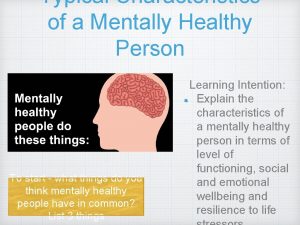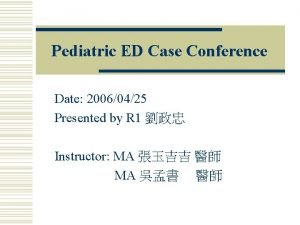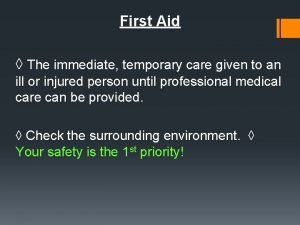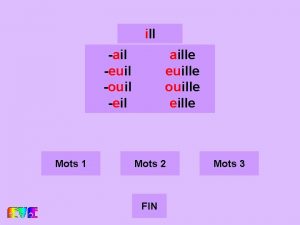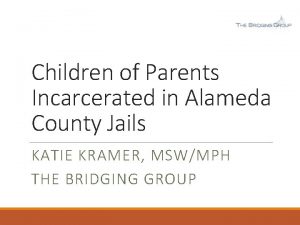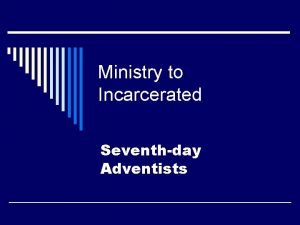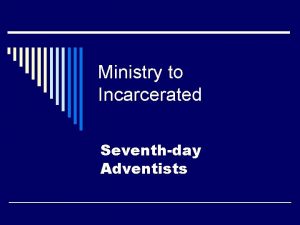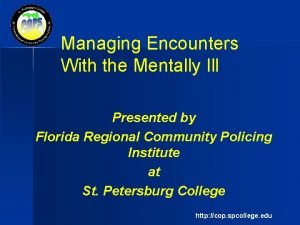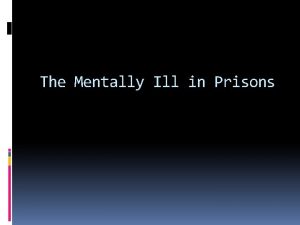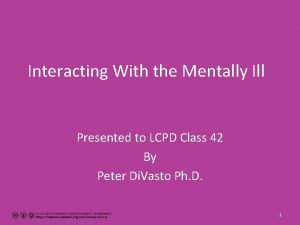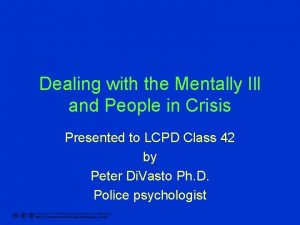TREATMENT ALTERNATIVE FOR INCARCERATED MENTALLY ILL Two jails










































- Slides: 42

TREATMENT ALTERNATIVE FOR INCARCERATED MENTALLY ILL: Two jails - Post-CIT implementation CIT International Conference August 17, 2017 National Institute of Corrections U. S. Department of Justice

Workshop Objectives • Describe NIC’s Phase I & Phase II CIT Initiative • Present two agency testimonials for CIT in detention Broward County Sheriff’s Department Dane County Sheriff’s Department • Explain the NIC training opportunity/Technical Assistance request process • Entertain questions regarding CIT Program implementation & sustainability

Description: The CIT Program applies to jails, prisons, and community corrections agencies alike. It focuses on building an agency's capacity to implement a locally owned and administered CIT program and the training for that program. Detention & corrections agencies frequently share their successful programs with patrol/police-based agencies in their local areas.

ESSENTIAL COMPONENTS OF CIT TRAINING Knowledge Building Partnership with Mental Health, Law Enforcement, and community advocacy groups Basic psycho-educational training on mental health conditions Personal Contact Consumer and family conversation Field/Site visit to a mental health treatment center Skill Building and Problem Solving Verbal de-escalation training 8 -hour Roleplaying Scenarios Hearing Voices Exercise

CORRECTIONAL SELF-INTEREST Self-Care & Compassion Fatigue Verbal De-escalation Skill Training

ENGAGEMENT WITH THE TRAINING AUDIENCE HEARING VOICES EXERCISE ROLEPLAYING RELEVANT SCENARIOS

From December 2010 to 2013, in Aurora, CO, NIC trained staff representing 19 jail systems, 20 DOCs and one team from U. S. Probation & Parole. Colorado Connecticut Delaware District of Columbia Florida Hawaii Idaho Indiana Iowa Kentucky Louisiana Minnesota Missouri New York North Carolina Pennsylvania Tennessee Virginia West Virginia Wisconsin

19 jail systems - (12 systems listed) Adams County Sheriff’s Department, Thornton, CO Allegheny County Jail, Pittsburgh, PA Chautauqua County Sheriff’s Office, Mayville, NY Collier County Sheriff’s Office, Naples, FL Frederick County Detention Center, Frederick, MD Geauga County Sheriff’s Office, Chardon, OH Green Lake County Sheriff’s Office, Green Lake, WI Hennepin County Adult Correctional Facility, Delano, MN Lafayette Parish Sheriff’s Office, Lafayette, LA Merrimack County House of Corrections, Boscawen, NH Wabash Valley Correctional Facility, Carlisle, IN Washington County Sheriff’s Office, Gray, TN

2014 to present Broward County Sheriff’s Office (Fort Lauderdale, FL) Charleston County Sheriff’s Office (Charleston, SC) Dane County Sheriff’s Office (Madison, WI) Douglas County Department of Corrections (Omaha, NE) Franklin County Sheriff’s Office (Columbus, OH) Hudson County Department of Corrections (Hudson, NJ) LA County Sheriff’s Department (Los Angeles, CA) Lexington County Department of Corrections (Lexington, KY)

2014 to present Maryland Department of Public Safety Missouri Department of Corrections Ohio Department of Corrections & Rehabilitation South Carolina Department of Corrections Tennessee Department of Corrections Virginia Department of Corrections West Virginia Department of Corrections

TREATMENT ALTERNATIVE FOR INCARCERATED MENTALLY ILL: Dane County Sheriff’s Department Capt. Richelle Anhalt, Jail Administrator

THE PROBLEM A person with a mental illness is more likely to be incarcerated and will typically have a longer length of stay. The mean ALOS for this population in the Dane County Jail is 36. 9 days (58% higher than the overall jail population ALOS of 23. 4 days) Medical/Mental Health services in the jail focus on immediate need for symptom relief not long-range treatment.

THE PROBLEM Most facilities are not designed with the Mental Health function in mind.

WHY CIT? Increases the knowledge and skills of jail staff to effectively manage and respond to persons with mental illness. CIT provides an effective response that: Enhances institutional management; Enhances support, supervision and community collaboration; Reduces liability, and above all; Increases the safety for all.

GOALS FOR CIT TRAINING Knowledge Building Understanding mental illnesses Current medications & treatments Substance use disorders & co-occurring disorders Mental retardation and autism Medical conditions & mental illnesses Legal Issues • Provide additional ways to de-escalate a crisis situation. Provide alternatives for dealing with people in crisis.

CIT – THE BENEFITS • Specially-trained Officers for an immediate response; • Effective interaction with individuals who may be in crisis and/or consumers of the mental health system; • Reduced injuries to officers, inmates, staff; • Reduced liability; • Improved access to mental health services and; • Meaningful collaboration between the jail, community service providers, and advocates.

TRIUMPHS • Specially-trained Officers for an immediate response; • Reduced injuries to officers, inmates, staff; • Reduced liability; • Improved access to mental health services and; • Improved communication and collaboration between disciplines.

CHALLENGES • How do we measure success? • Is it the number of officers trained? • Did the training provide additional ways to deescalate and provide alternatives for managing a crisis situation ? • Did the training improve understanding of Mental Illness and Mental Health Issues? • Did it give staff more confidence? • What data do we collect? • Inability to connect mental health data and jail data

THE SITUATION Deputies were conducting a security check and noticed that an inmate in the cellblock was unusually agitated and displaying strange behavior. The Deputy determined that he was having a mental health crisis requested an evaluation by medical/mental health staff. Due to the inmate’s level of agitation (punching the cell wall, hitting his head and screaming things that made no sense) additional deputies were requested to assist and form a cell entry team.

THE RESPONSE The CIT trained Deputy remained at the cellblock speaking with the inmate, utilizing her verbal skills and learned techniques to get the inmate to calm down. When it was safe to do so, the deputy entered the cellblock and explained what was going to happen.

THE OUTCOME The deputy was able to effectively use her CIT training to diffuse the situation. She showed empathy towards the inmate throughout the entire encounter. Her actions prevented what could have been a violent encounter with an inmate suffering from a mental crisis. No one was injured. No Force was used.

TREATMENT ALTERNATIVE FOR INCARCERATED MENTALLY ILL: Broward County Sheriff’s Department Lt. Colonel E. Keith Neely, Retired

CRISIS INTERVENTION TEAMS (CIT) THE BROWARD COUNTY DETENTION STORY Present case: implementing CIT – SUCCESS STORY! Broward County Sheriff’s Office (BSO), Department of Detention (DOD) Transitioned from Mental Health Training to the National Institute of Corrections, CIT model

NORTH BROWARD DETENTION CENTER Demographic Information: 1206 bed capacity Houses male and female general population and special needs inmates 254 bed Mental Health Housing Unit 114 Infirmary beds for males and females 297 Broward Sheriff’s Office Staff 72 Medical staff (contracted vendor)

THE BROWARD DETENTION STORY § In 2003 implemented specialized MH training to all staff working on the Mental Health Housing Unit and other key areas § Implemented Special Needs Management Team Concept § Administrative selection and placement of specific staff working in the Mental Health Unit § Developed relationship with local universities for the use of Master’s and Doctoral level interns for the provision of inmate programming

THE BROWARD DETENTION STORY Provide special needs programs to promote inmate mental health and success upon transition into GP or broader community Developed housing plan that allows for placement based on level of psychiatric and behavioral functioning Improve and increase inmate discharge /transition planning by facilitating closer collaboration among BSO and community agencies Contracted annually 40 hour MH Training

INITIAL RESULTS FOLLOWING MENTAL HEALTH TRAINING (COMPLETED IN 2004) Pre-training Post-training Grievances 22 9 59% Battery on staff 41 16 60% Attempted suicide 12 11 8% Restraint Chair 13 12 9%

2016: TRANSITIONED TO CIT § Realized that our current Mental Health Training was not sustainable nor sufficient § In 2015 engaged the National Institute of Corrections regarding their CIT Model § Requested Technical Assistance (TA) from the National Institute of Corrections (NIC) § Site visit by NIC program staff

2016: TRANSITIONED TO CIT § Utilized expert trainers provided by NIC § A unique training initiative § 40 hours of practical training (active skills development) § Initial Training in March 2016 § Training Classes held: September 2016; March 2017; and future training class: September 2017

2016: TRANSITIONED TO CIT Why CIT? Clear policy (SOP) and expectations CIT Committees (steering, training and facility committees) Collaboration of community partners who were previously not engaged

COMMUNITY PARTNERS FOR LOCAL JAILS Local NAMI Chapter United Way Broward Behavioral Health Coalition Local Law Enforcement CIT Program Mental Health Court Local Universities / Colleges

DEMONSTRATED BENEFITS OF CIT § CIT is comprehensive, formalized and ongoing § Proven Results (data driven) § A multi-disciplinary team approach (sworn, civilians, medical)

DEMONSTRATED BENEFITS OF CIT § Cooperative and collaborative approach in the management of the mentally ill inmate § Partnerships between BSO Detention and community mental health providers (community ownership)

BSO - KEEPING THE MOMENTUM § Formal graduation and recognition § Certificates and CIT PINs provided § Annual refresher to include de-escalation training during In-Service Training Program.

BSO - KEEPING THE MOMENTUM § Established CIT coordinator § 8 Hour Annual Refresher § Our Goal: Two CIT trainings annually

TECHNICAL ASSISTANCE DESCRIPTION AND PROCESS Application to NIC One day site visit 2 -3 months prior to CIT week Goals Education on CIT Planning assistance for CIT week Evaluation of readiness Consultation & Supports Frequent planning conference calls Week long – 40 hr training M-F or Thurs - Mon Post CIT Week check – in and progress assessment

18 –month commitment to CIT Program Initiation Director/Jail Administrator submits TA memo to mpjackson@bop. gov or whill@bop. gov If agency found to be ready for partnership program, 40 hour training approved Requesting NIC Technical Assistance NIC evaluates TA request Onsite assessment conducted to assess readiness If approved, site assessment process begins

COS TS? ?

ADDITIONAL INFORMATION http: //www. nami. org/ http: //www. nmha. org/ National Empowerment Center http: //power 2 u. org/ CIT Center http: //www. cit. memphis. edu/ The New Asylum Released Ending the Silence (NAMIsponsored) www. pbs. org/wgbh/pages/frontline/shows/asylums/ http: //video. pbs. org/video/1114528522/ http: //www. youtube. com/watch? v=UI 11152 j 3 Zg

For additional information, please contact: Sandora B. Cathcart, BSW, MS Correctional Program Specialist National Institute of Corrections Jails Division Washington, DC 20534 202 -616 -9590 scathcart@bop. gov

http: //nicic. gov

Thank you for your attention! National Institute of Corrections U. S. Department of Justice
 Mutilomania
Mutilomania Taxis in hernia
Taxis in hernia Naraths hernia
Naraths hernia Total jails in punjab
Total jails in punjab Eyes on the prize ain't scared of your jails summary
Eyes on the prize ain't scared of your jails summary Years solitary confinement
Years solitary confinement First generation jails
First generation jails Characteristics of mentally healthy person
Characteristics of mentally healthy person How do we multiply fractions mentally
How do we multiply fractions mentally Lesson 3 add and subtract mentally
Lesson 3 add and subtract mentally How to divide fractions mentally
How to divide fractions mentally Parts of subtraction problem
Parts of subtraction problem Previewing helps the audience mentally organize a speech.
Previewing helps the audience mentally organize a speech. Viewpoint composition photography
Viewpoint composition photography Corporate athlete model
Corporate athlete model Mentally spiritually physically emotionally
Mentally spiritually physically emotionally Thinking involves mentally grouping similar objects
Thinking involves mentally grouping similar objects Assimilate mentally
Assimilate mentally Self actualization qualities
Self actualization qualities How did you spend your last weekend
How did you spend your last weekend Rapid ill
Rapid ill Ticls
Ticls This supernatural soliciting cannot be ill cannot be good
This supernatural soliciting cannot be ill cannot be good An immediate temporary care given to an injured victim
An immediate temporary care given to an injured victim Stalling objection example
Stalling objection example Doing nothing is doing ill
Doing nothing is doing ill Care of critically ill surgical patient
Care of critically ill surgical patient V
V Mnt critically ill
Mnt critically ill Second conditional put the verb into the correct tense
Second conditional put the verb into the correct tense Concepts of ill health
Concepts of ill health Euill
Euill Where you go i'll go where you stay ill stay
Where you go i'll go where you stay ill stay Suffix of ill
Suffix of ill You said i am feeling ill in indirect speech
You said i am feeling ill in indirect speech Rising action of the sob sisters story
Rising action of the sob sisters story Tell me and ill forget
Tell me and ill forget She worked hard. she made herself ill
She worked hard. she made herself ill 25 bad manners
25 bad manners Scream and ill tell your mom
Scream and ill tell your mom Song ill be waiting
Song ill be waiting Ill methodology workshop
Ill methodology workshop Dear mum and dad
Dear mum and dad







